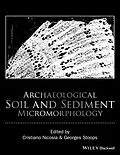Archaeological Soil and Sediment Micromorphology goes beyond a mere review of current literature and features the most up to date contributions from numerous scientists working in the field. The book represents a groundbreaking and comprehensive resource covering the plethora of applications of micromorphology in archaeology. Archaeological Soil and Sediment Micromorphology offers researchers, students and professionals a systematic tool for the interpretation of thin sections of archaeological contexts.
This important resource is also designed to help stimulate the use of micromorphology in archaeology outside Europe, where the technique is less frequently employed. Moreover, the authors hope to strengthen the proper application of soil micromorphology in archaeology, by illustrating its possibilities and referring in several cases to more specialized publications (for instance in the field of plant remains, pottery and phytoliths). Written for anyone interested in the topic, this important text offers:
* Contributions from most of the world's leading authorities on soil micromorphology
* A series of chapters on the major topics selected among the most recurrent in literature about archaeological soil micromorphology
* Systematic descriptions of all important micromorphological features
* Special analytical tools employed on thin sections, such as SEM/EDS, image analysis, fluorescence microscopy, mass spectrometry, among others
* Numerous cross-references
* 400 illustrated full-colour plates
The resource provides the most current and essential information for archaeologists, geoarchaeologists, soil scientists and sedimentologists. Comprehensive in scope, Archaeological Soil and Sediment Micromorphology offers professionals and students a much-needed tool for the interpretation of thin sections of archaeological contexts.
Autorentext
Dr. Cristiano Nicosia, Centre de Recherches en Archéologie et Patrimoine, Universitè Libre de Bruxelles, Belgium
Em. Prof. Dr. Georges Stoops, Vakgroep Geologie, Universiteit Gent, Belgium
Zusammenfassung
Archaeological Soil and Sediment Micromorphology goes beyond a mere review of current literature and features the most up to date contributions from numerous scientists working in the field. The book represents a groundbreaking and comprehensive resource covering the plethora of applications of micromorphology in archaeology. Archaeological Soil and Sediment Micromorphology offers researchers, students and professionals a systematic tool for the interpretation of thin sections of archaeological contexts.
This important resource is also designed to help stimulate the use of micromorphology in archaeology outside Europe, where the technique is less frequently employed. Moreover, the authors hope to strengthen the proper application of soil micromorphology in archaeology, by illustrating its possibilities and referring in several cases to more specialized publications (for instance in the field of plant remains, pottery and phytoliths). Written for anyone interested in the topic, this important text offers:
- Contributions from most of the world's leading authorities on soil micromorphology
- A series of chapters on the major topics selected among the most recurrent in literature about archaeological soil micromorphology
- Systematic descriptions of all important micromorphological features
- Special analytical tools employed on thin sections, such as SEM/EDS, image analysis, fluorescence microscopy, mass spectrometry, among others
- Numerous cross-references
- 400 illustrated full-colour plates
The resource provides the most current and essential information for archaeologists, geoarchaeologists, soil scientists and sedimentologists. Comprehensive in scope, Archaeological Soil and Sediment Micromorphology offers professionals and students a much-needed tool for the interpretation of thin sections of archaeological contexts.
Inhalt
Contributors xiii
Referees xvii
Abbreviations xix
Introduction 1
Georges Stoops and Cristiano Nicosia
I.1 Aims and Structure of the Book 1
I.2 Definition and History of Soil Micromorphology 1
I.3 Micromorphology and Archaeology 2
I.4 Use of Micromorphology in Geoarchaeology 2
I.5 Techniques 4
I.6 Concluding
Remarks 5
References 5
Part I: Inclusions in Archaeological Soils and Sediments 9
1 Bone and Other Skeletal Tissues 11
Ximena S. Villagran, Dirk J. Huisman, Susan M. Mentzer, Christopher E. Miller and Miranda M. Jans
1.1 Introduction 11
1.2 Micromorphology 11
1.3 Taphonomy of Bone 20
1.4 Guidelines for Micromorphological Analysis 32
References 33
2 Avian Eggshell 39
Matthew G. Canti
2.1 Introduction 39
2.2 Biological Characteristics 39
2.3 Optical and Morphological Properties 39
2.4 Examples 39
2.5 Conclusions 39
References 41
3 Mollusc Shell 43
Matthew G. Canti
3.1 Biological Characteristics 43
3.2 Optical and Morphological Properties 43
3.3 Examples 43
3.4 Conclusions 46
References 46
4 Biospheroids Produced by Earthworms 47
Matthew G. Canti
4.1 Introduction 47
4.2 Morphological and Optical Characteristics 47
4.3 Preservation Potential 47
4.4 Archaeological
Examples 47
4.5 Arion Granules 49
References 49
5 Faecal Spherulites 51
Matthew G. Canti and Jacques Élie Brochier
5.1 Introduction 51
5.2 Biological Characteristics 51
5.3 Optical Characteristics 51
5.4 Preservation Potential 53
5.5 Archaeological
Examples 53
References 54
6 Excrements of Herbivores 55
David Brönnimann, Kristin IsmailMeyer, Philippe Rentzel, Christine Pümpin and Lenka Lisá
6.1 Introduction 55
6.2 Micromorphology 55
6.3 Taphonomy 60
References 63
7 Excrements of Omnivores and Carnivores 67
David Brönnimann, Christine Pümpin, Kristin IsmailMeyer, Philippe Rentzel and Natalia Égüez
7.1 Introduction 67
7.2 Excrements of Omnivores 67
7.3 Excrements of Carnivores 69
7.4 Human Excrements 75
7.5 Future
Research 77
References 78
8 Guano 83
Panagiotis Karkanas
8.1 Introduction 83
8.2 Micromorphology 83
8.3 Archaeological Implications 86
8.4 Future Prospects 87
References 87
9 Ova of Intestinal Parasites 91
Christine Pümpin, Matthieu Le Bailly and Sandra Pichler
9.1 Introduction 91
9.2 Characteristics of Specific Parasite Eggs 91
9.3 Limitations of the Study of Helminth Eggs in Micromorphological Thin Sections 94
9.4 Conclusion 96
References 96
10 Earth Construction Materials 99
David E. Friesem, Julia Wattez and Marylise Onfray
10.1 Introduction 99
10.2 Mud
Bricks 99
10.3 Cob 102
10.4 Wattle and Daub 104
10.5 Conclusion 106
References 107
11 Laterite as Construction Material 111
Georges Stoops
References 112
12 Turf as...
